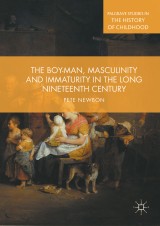Details

The Boy-Man, Masculinity and Immaturity in the Long Nineteenth Century
Palgrave Studies in the History of Childhood
|
CHF 177.00 |
|
| Verlag: | Palgrave Macmillan |
| Format: | |
| Veröffentl.: | 04.09.2018 |
| ISBN/EAN: | 9781137408143 |
| Sprache: | englisch |
Dieses eBook enthält ein Wasserzeichen.
Beschreibungen
<p>This book explores the evolution of male writers marked by peculiar traits of childlike immaturity. The ‘Boy-Man’ emerged from the nexus of Rousseau’s counter-Enlightenment cultural primitivism, Sensibility’s ‘Man of Feeling’, the Chattertonian poet maudit, and the Romantic idealisation of childhood. The Romantic era saw the proliferation of boy-men, who congregated around such metropolitan institutions as <i>The London Magazine</i>. These included John Keats, Leigh Hunt, Charles Lamb, Hartley Coleridge, Thomas De Quincey and Thomas Hood. In the period of the French Revolution, terms of childishness were used against such writers as Wordsworth, Keats, Hunt and Lamb as a tool of political satire. Yet boy-men writers conversely used their amphibian child-adult literary personae to critique the masculinist ideologies of their era. However, the growing cultural and political conservatism of the nineteenth century, and the emergence of a canon of serious literature, inculcated the relegation of the boy-men from the republic of letters. </p>
Introduction: Too Much the Boy-Man.- Self-Incurred Immaturity.- Literary Origins: Sterne, Rousseau, Chatterton, and Wordsworth.- Namby-Pamby Wordsworth.- The Marks of Infancy Were Burned Into Him.- Chapter 6: Little Johnny Keats: A Boy of Pretty Abilities.- Lamb and the Age of Cant: Jokes, Puns, and Nonsense.- Hartley Coleridge and the Muscular Christians.- Pantomime and the Politics of Play.- The Dark Interpreter: De Quincey, and the Legacy of Wordsworthian Childhood.- A Farewell to Skimpole: Romantic Boy-Men and Canonical Occlusion.- Index
<p>Pete Newbon is Senior Lecturer in Romantic and Victorian Literature at Northumbria University, UK.</p>
<p>This book explores the evolution of male writers marked by peculiar traits of childlike immaturity. The ‘Boy-Man’ emerged from the nexus of Rousseau’s counter-Enlightenment cultural primitivism, Sensibility’s ‘Man of Feeling’, the Chattertonian poet maudit, and the Romantic idealisation of childhood. The Romantic era saw the proliferation of boy-men, who congregated around such metropolitan institutions as <i>The London Magazine</i>. These included John Keats, Leigh Hunt, Charles Lamb, Hartley Coleridge, Thomas De Quincey and Thomas Hood. In the period of the French Revolution, terms of childishness were used against such writers as Wordsworth, Keats, Hunt and Lamb as a tool of political satire. Yet boy-men writers conversely used their amphibian child-adult literary personae to critique the masculinist ideologies of their era. However, the growing cultural and political conservatism of the nineteenth century, and the emergence of a canon of serious literature, inculcated the relegation of the boy-men from the republic of letters. <br></p>
Examines the role of childlikeness and immaturity in the literary and artistic creativity of prominent boy-men of the nineteenth century Explores the impact that grownup-children had on the cultures of childhood and masculinity Analyses the transition between Romanticism and Victorianism, and the impact of Romantic conceptions of childhood upon masculine identity

















